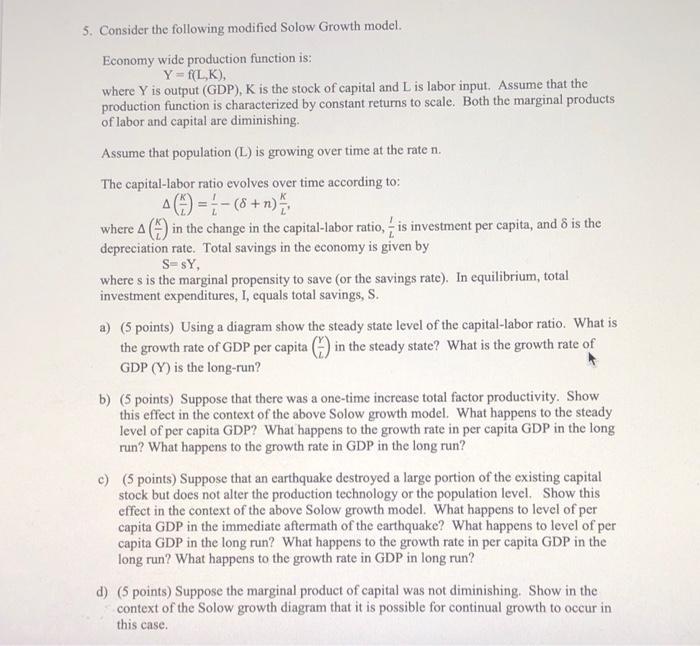5. Consider the following modified Solow Growth model. Economy wide production function is: Y = f(L,K), where Y is output (GDP), K is the

5. Consider the following modified Solow Growth model. Economy wide production function is: Y = f(L,K), where Y is output (GDP), K is the stock of capital and L is labor input. Assume that the production function is characterized by constant returns to scale. Both the marginal products of labor and capital are diminishing. Assume that population (L) is growing over time at the rate n. The capital-labor ratio evolves over time according to: 4() = -(8 + n), where A() in the change in the capital-labor ratio, is investment per capita, and 8 is the depreciation rate. Total savings in the economy is given by S-SY, where s is the marginal propensity to save (or the savings rate). In equilibrium, total investment expenditures, I, equals total savings, S. a) (5 points) Using a diagram show the steady state level of the capital-labor ratio. What is the growth rate of GDP per capita in the steady state? What is the growth rate of GDP (Y) is the long-run? b) (5 points) Suppose that there was a one-time increase total factor productivity. Show this effect in the context of the above Solow growth model. What happens to the steady level of per capita GDP? What happens to the growth rate in per capita GDP in the long run? What happens to the growth rate in GDP in the long run? c) (5 points) Suppose that an earthquake destroyed a large portion of the existing capital stock but does not alter the production technology or the population level. Show this effect in the context of the above Solow growth model. What happens to level of per capita GDP in the immediate aftermath of the earthquake? What happens to level of per capita GDP in the long run? What happens to the growth rate in per capita GDP in the long run? What happens to the growth rate in GDP in long run? d) (5 points) Suppose the marginal product of capital was not diminishing. Show in the context of the Solow growth diagram that it is possible for continual growth to occur in this case.
Step by Step Solution
3.41 Rating (145 Votes )
There are 3 Steps involved in it
Step: 1

See step-by-step solutions with expert insights and AI powered tools for academic success
Step: 2

Step: 3

Ace Your Homework with AI
Get the answers you need in no time with our AI-driven, step-by-step assistance
Get Started


